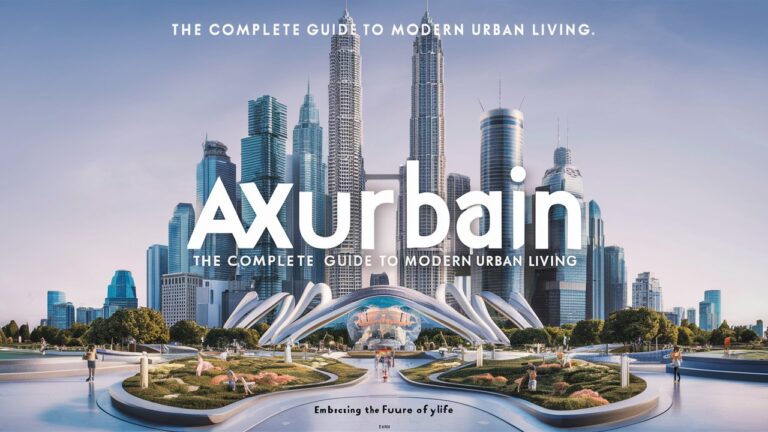Introduction
Imagine a city that breathes with you — one that adjusts its rhythms to your moods, anticipates your needs, and balances chaos with calm. Now, picture this city not as a far-off sci-fi fantasy but as a concept taking root today. That’s axurbain: a buzzword, a movement, a manifesto for the next phase of urban evolution.
While it might sound like another fancy tech startup name, axurbain goes beyond digital gimmicks. It’s about merging human intuition with smart systems to create cities that live, learn, and listen. Think of it as the symphony where technology meets humanity — not clashing, but harmonizing.
So, what exactly is axurbain? How does it promise to change the way we live, move, and dream within our cities? Buckle up — this is going to be quite the ride!
What Is Axurbain, Really?
At its core, axurbain is a blend of “axis” and “urbain” (the French word for “urban”). The idea? To establish a new axis or central line of balance between modern technology and the organic pulse of city life.
It’s not just another smart city trend. Nope. It’s a philosophy — a mindset that promotes:
- Adaptive architecture: Buildings that respond to climate and user behavior.
- Human-centered tech: Devices and networks that serve people first, not data.
- Eco-intelligent design: Sustainability that’s seamless, not preachy.
- Cultural connectivity: Urban spaces that celebrate diversity and interaction.
In simpler terms, axurbain is about making cities not only smarter but kinder.
The Heartbeat of the Axurbain City
Ever felt that cities have a pulse — the rush of traffic, the chatter of cafés, the hum of neon lights? Well, an axurbain city takes that pulse and gives it rhythm.
Here’s what that looks like in practice:
1. Dynamic Districts
Gone are the rigid zones of old — business here, residential there. In an axurbain setup, everything’s fluid. Workspaces morph into social hubs by evening, parks double as outdoor offices, and rooftops transform into mini-farms.
2. Tech That Feels Invisible
Forget blinking screens and noisy notifications. Axurbain technology operates quietly in the background — from self-regulating energy grids to traffic systems that reroute in real-time. It’s the kind of tech you don’t notice, yet can’t live without.
3. Green as the New Gray
Concrete jungles? Out. Vertical gardens, moss-covered facades, and solar-panel sidewalks? In. The axurbain aesthetic blends greenery with geometry — creating spaces that soothe both the eye and the planet.
4. Social Fluidity
Urban loneliness — that silent epidemic — gets tackled head-on. Shared spaces, community kitchens, and AI-driven cultural mixers bring people together in organic, meaningful ways.
The Philosophy Behind Axurbain
To grasp axurbain’s depth, you’ve got to understand its driving belief: cities should feel alive, not automated.
It’s a rejection of sterile, tech-obsessed urban planning. Instead, it argues for:
- Empathy-driven innovation — Tech should understand emotions, not just actions.
- Interconnected ecosystems — Infrastructure, people, and nature working as one.
- Sustainable circularity — Waste becomes resource; movement becomes mindfulness.
Think of it as a blend between Zen gardens and smart grids — a cityscape designed to enhance consciousness as much as convenience.
The Evolution Toward Axurbain
How did we even get here? It’s not like cities suddenly woke up enlightened. The axurbain model evolved out of necessity. Let’s break it down:
- The Overload Era
First came the smart city boom — sensors everywhere, data overload, and a disconnect between people and the systems built to serve them. - The Sustainability Panic
Then came climate anxiety. Cities were forced to rethink consumption, energy, and carbon footprints. - The Human Reclamation
Finally, a shift: people wanted their cities back. Enter axurbain — the human-tech hybrid solution where well-being meets innovation.
Real-World Inspirations
Though “axurbain” may sound conceptual, glimpses of it already exist across the globe.
- Copenhagen — cycling lanes integrated with smart lights that adapt to traffic flow.
- Singapore — high-rise farms reducing food miles.
- Barcelona — superblocks that limit car access, creating pedestrian-first zones.
- Tokyo — micro-homes designed with multifunctional smart systems.
These aren’t just isolated ideas. They’re hints of an axurbain mindset taking hold — one brick, one byte, one breath at a time.
Axurbain Living: What’s It Like?
Let’s paint a picture.
You wake up to soft sunlight filtering through adaptive glass that adjusts opacity based on your sleep cycle. Your breakfast is made with ingredients sourced from your rooftop garden.
Stepping outside, an autonomous shuttle greets you — quiet, sleek, and perfectly timed. The streets are alive but calm. You work from a co-living café where conversations flow easily because, well, everyone feels connected.
That’s axurbain life — personalized yet communal, high-tech yet deeply human.
The Daily Benefits of an Axurbain Lifestyle:
- Zero stress commutes thanks to predictive transport systems.
- Cleaner air and water due to integrated eco-filtration infrastructure.
- Time savings through automation that anticipates your needs.
- Higher well-being via designed calm zones and green corridors.
Challenges on the Road to Axurbain
Of course, no transformation is without bumps. The axurbain vision faces real-world hurdles:
- Cost and Accessibility
Building adaptive infrastructure isn’t cheap. Without inclusive planning, only elite cities could afford to go “axurbain.” - Privacy Concerns
With integrated AI comes data — lots of it. The question remains: who controls it? - Cultural Resistance
Not everyone’s ready for a life so intertwined with technology. Balancing innovation with cultural heritage is crucial. - Policy Lag
Urban planning laws often trail decades behind technological reality. Updating regulations to match the axurbain pace is key.
But here’s the thing — every major leap in civilization faced skeptics. From electricity to the internet, progress always begins as disruption.
How Axurbain Redefines Sustainability
We’ve heard the buzzwords — “net-zero,” “green city,” “carbon neutral.” But axurbain dares to go further: it makes sustainability feel natural.
Here’s how:
- Energy Fluidity: Buildings exchange power dynamically — one’s excess becomes another’s supply.
- Urban Agriculture: Food isn’t imported, it’s grown vertically or hydroponically nearby.
- Circular Waste: Trash collection? Gone. Smart systems repurpose waste into materials for new projects.
- Water Harmony: Every drop is monitored, recycled, and redirected efficiently.
In an axurbain city, sustainability isn’t a policy — it’s the default.
The Aesthetic of Axurbain
Beauty matters. A lot.
Axurbain aesthetics combine minimalism with emotion — where geometry meets greenery. Architecture flows, spaces breathe, and design whispers calm instead of shouting luxury.
Expect to see:
- Organic curves replacing hard corners.
- Soft materials paired with sensor tech.
- Nature-inspired color palettes — think moss greens, sand tones, sky blues.
- Art installations that double as public tech interfaces.
It’s design that invites you to slow down — to actually feel where you are.
The Human Factor
At the end of the day, technology is just the tool. People — their emotions, behaviors, and values — form the soul of axurbain.
Here’s how humans remain at the center:
- Community councils powered by digital voting but driven by empathy.
- Public art initiatives that encourage creative ownership of shared spaces.
- Inclusive design ensuring accessibility for all, from children to seniors.
It’s a reminder that the smartest city is the one that makes people feel seen.
Frequently Asked Questions (FAQs)
Q1: Is axurbain just another word for a smart city?
Not exactly. While smart cities emphasize technology, axurbain emphasizes balance — between tech, nature, and human experience.
Q2: How far are we from realizing full axurbain cities?
Some cities already show elements of it, but a complete transition could take 20–30 years, depending on political will and investment.
Q3: Can smaller towns adopt the axurbain model?
Absolutely! Axurbain isn’t about size — it’s about mindset. Even small communities can integrate adaptive design and local sustainability practices.
Q4: What’s the biggest risk of pursuing axurbain too fast?
Losing touch with cultural identity. Cities must evolve without erasing the soul that makes them unique.
The Road Ahead: From Vision to Reality
The dream of axurbain isn’t just blueprints and buzzwords — it’s a living promise. The next few decades will test whether humanity can design cities that nurture, not exhaust.
Imagine future generations growing up in environments that teach mindfulness, empathy, and ecological respect — all through the architecture that surrounds them.
Sounds poetic, doesn’t it? But that’s exactly what makes axurbain powerful. It’s not a product to buy — it’s a vision to build.
Conclusion
The axurbain revolution isn’t waiting for tomorrow; it’s quietly taking root today. From smart buildings that heal themselves to neighborhoods designed around emotional well-being, the world’s urban DNA is rewriting itself.
And maybe — just maybe — this time, we’ll get it right.
Because in the end, the true magic of axurbain isn’t in its gadgets or glass towers. It’s in the harmony it dares to restore — between progress and peace, machine and man, chaos and calm.
Welcome to the age of axurbain. The city that finally feels alive.

